But you won’t be able to study effectively if you’re burned out, irritable and exhausted.
So it’s time to get serious about self care.
Self care practices will keep you mentally and physically strong.
But before we look at a range of self care practices, you first need to come to grips with the Self Care Paradox.
The Self Care Paradox is the idea that the more time and energy you give to taking care of yourself, the more time and energy you’ll have to do the things that matter most to you.
In other words, spending time cooking a healthy meal, going for a walk or having a power nap is time well spent. You’ll get that time back since you’ll have greater energy levels and sharper focus.
In short, you’ll be able to get more study done in less time.
Forget lazing by a pool in Bali or going on a yoga retreat. These are expensive and unsustainable ways to look after yourself.
What you need are mini relaxation exercises and micro-retreats scattered throughout your day. The key is to listen to your body and stop to recharge before you become completely exhausted.
I’ve found even just taking a few 30 second breaks throughout the day can make a huge difference to my energy levels and wellbeing.
It’s easy to fall into the trap of thinking, “I don’t have time to exercise” or “I’m too busy to nap!”. But when you’re flat out that’s when you need to take care of yourself more than usual.
Because when you’re well rested you’re in a much better position to handle the challenges life throws at you.
In the great book The Sophrology Method Florence Parot states:
“ … whatever you do, life happens! And it will keep happening, sometimes throwing things at you left, right and centre … the difference is how you are able to react. If you are tired, emotional, mentally drained, you are not going to be in a state to react very well.”
So how can you take care of yourself without spending an absolute fortune?
Below you’ll find a number of free or low cost self care activities to help you recharge, optimise your thinking and avoid burning out.
Pick a natural location: a park, the beach or even your own backyard. It doesn’t matter where you go in nature, but it does matter that you leave your phone at home. Disconnect from your devices to experience the full restorative effects of nature.
Research shows certain types of music can dramatically reduce your stress levels. In fact, one study found the song Weightless by Marconi Union resulted in a 65 percent reduction in participants’ overall anxiety levels.
Create a relaxation playlist and have it playing in the background.
Can’t be bothered curating your own playlist?
No problem. Spotify has put together a number of relaxing playlists for you. I find these genres and moods particularly relaxing:
• Low-Fi beats
• Yoga and meditation
• Deep focus
Get your thoughts and feelings down on paper. Write as if no one is going to read what you’re writing. Don’t censor yourself. Get everything out. The aim is to take the chaos out of your brain.
Writing can be a powerful way to help you sort out the jumbled mess of thoughts swirling around in your head. Putting whatever is worrying you down on paper can help you feel more in control.
A quick power nap has been shown to significantly decrease stress and fatigue and increase mental performance. Set a timer for 15-30 minutes, close your curtains and lie down. Say to yourself “Sleepy time!”. Don’t worry about falling into a deep sleep. You have one job to do (and one job only): to rest.
For more tips on how to enhance your power naps, click here.
Your brain needs two things to function well: oxygen and nutrients.
Smoothies are a great way to pack more nutrients into your day. I start my day with a Chocolate Blueberry Smoothie.
A few months ago a year 11 student told me, “My mum made your smoothie recipe for me and I felt great all day”. Try making it and see for yourself.
Exercise isn’t just for sporty people. We all need to get our hearts pumping and legs moving. Find some simple activities you enjoy doing (e.g. walking the dog, skipping, and stretching). Weave them into your daily routine.
In The Sophrology Method Florentine Parot shares a range of simple movement exercises you can do to release tension and develop more awareness of your body. One exercise involves slowly lifting your forearms up (breathing in) and then bringing your arms down by your sides (breathing out).
It’s important to remember that all movement counts (even gentle stretches).
Set yourself a goal to tidy your desk or a section of your room. Put a timer on for 5-15 minutes and start organising/cleaning your space.
There is something strangely satisfying and calming about cleaning and organising. When your space looks cleaner and more organised, you tend to feel more in control and on top of things.
In her fun book Craft for the Soul artist Pip Lincolne states micro-retreats are “a good preventative dose of cosy times so you don’t burn out”.
What does a micro-retreat look like?
According to Lincolne, it can involve one or more of the following activities:
• Making yourself a pot of tea
• Preparing some tasty snacks
• Watching your favourite show
• Having a bath
• Reading a book for pleasure
• Going for a walk and popping into a café
Do things that make you feel good. Why? As Lincolne says “…when you feel better, you tend to work better and think better”.
Meditation is an effective way to rapidly relax the body and focus the mind.
Here’s how you meditate in 5 simple steps:
1. Sit in a chair and get comfortable.
2. Focus on your breath going in and out.
3. Get distracted by a thought? Notice it and let it go.
4. Return your focus back to the breath going in and out.
5. Repeat steps 3 and 4 until a timer goes off.
If you need a little help with the process, check out apps such as 10% Happier and Headspace. These apps provide a range of guided meditations to ease your brain into the process.
Doing the same activity over and over again can be like a meditation. Instead of focusing your mind on your breath, your mind is focused on the task at hand. Your brain loves repetitive activities (as it gets to see immediate results).
Try doing one of the following:
• Knitting
• Chopping vegetables
• Weaving
• Shelling nuts
• Ironing
• Weeding
• Painting
For the cheapest massages around town, head to training institutes where students are learning how to master the art of massage.
For example, The Australian Institute of Fitness offers a 55-minute relaxing student massage for $25. A deep tissue massage (85 minutes) costs $40.
And just in case you’re thinking, “But are the massages any good?”
They certainly are. Amazingly good.
Taking care of yourself is about making little tweaks to your lifestyle and daily routine. It’s also about making sure you listen to your body and stop to recharge before you become a complete wreck.
So why not prioritise a few minutes for rest every day? You’ll be in a better position to handle the challenges life throws at you. Plus, you get to feel really good! And remember, when you feel good, you can study and think better too.
What is one thing you can do today to take better care of yourself?
Make it a priority. Schedule it in your diary like an appointment. Because if you don’t make time to rest, it probably won’t happen.
Share This:

Most of us do. We sit and stare at our screens or textbooks for large chunks of the day.
You’ve probably heard the phrase, “Sitting is the new smoking”. It sounds dramatic, but sitting for 30 minutes or more leads to:
• Reduced blood flow to the brain
• Increased blood pressure
• Increased blood sugar
• Reduced positive emotions
Even if you exercise at the gym, if you sit all day at work or school, that’s not good for you.
Most of us know we should move more and sit less, but knowledge doesn’t always translate into action.
I’ve known for years about the harms of sitting. Every year, I’d set a goal “To move more during the day”. But it wasn’t until this year that I finally got off my butt and started taking regular movement breaks. In this blog, I’ll share what made all the difference.
Part of my problem was telling myself to “move more” and “sit less”. This was way too vague for my brain.
When it comes to taking movement breaks, how long should we move for? How frequently? And at what intensity?
I recently came across a brilliant study, published in 2023, that answered some of these questions.
A team of researchers at Columbia University compared different doses of movement on several health measures (e.g., blood sugar, blood pressure, mood, cognitive performance, and energy levels).
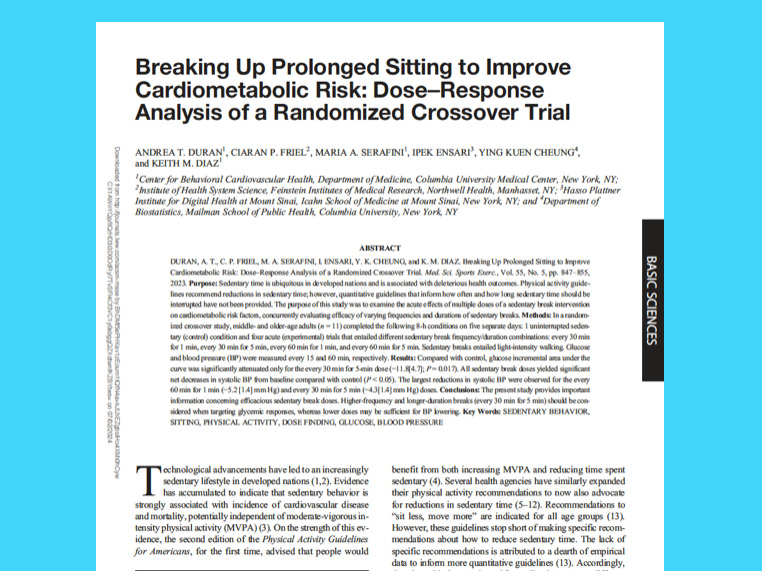
The researchers were interested in exploring how often and for how long we need movement breaks to offset some of the harms of sitting for long periods.
So, what did they do in this study?
Researchers brought participants into the lab and made them sit in an ergonomic chair for 8 hours. Participants could only get up to take a movement break or go to the toilet.
They tested five conditions:
• Uninterrupted sedentary (control) condition (Note: no movement breaks)
• Light-intensity walking every 30 minutes for 1 minute
• Light-intensity walking every 30 minutes for 5 minutes
• Light-intensity walking every 60 minutes for 1 minute
• Light-intensity walking every 30 minutes for 5 minutes
The optimal amount of movement was five minutes every 30 minutes. This movement dose significantly reduced participants’ blood sugar and blood pressure and improved their mood and energy levels.
That said, even a low dose of movement (one minute of movement every 30 minutes) was found to be beneficial.
Although walking has been described as ‘gymnastics for the mind’ and numerous studies show brisk walking can improve cognitive performance, they found no significant improvements in participants’ cognitive performance in this particular study.
You can read the full study here.
When it comes to any research conducted in the lab, the question worth asking is: Is it possible for people to do this in the real world? And if so, will they experience similar benefits?
Journalist Manoush Zomorodi wanted to find out. So, she teamed up with Columbia University researchers to explore whether people could incorporate regular five-minute movement breaks into their day.
They created a two-week challenge where people could sign up to one of three groups:
1) Five-minute movement breaks every 30 minutes
2) Five-minute movement breaks every hour
3) Five-minute movement breaks every two hours
Over 23,000 people signed up to participate in the challenge. Sixty per cent completed the challenge.
What did they find?
Five-minute movement breaks improved people’s lives, whether taken every half hour, hour, or two hours. They felt less tired and experienced more positive emotions.
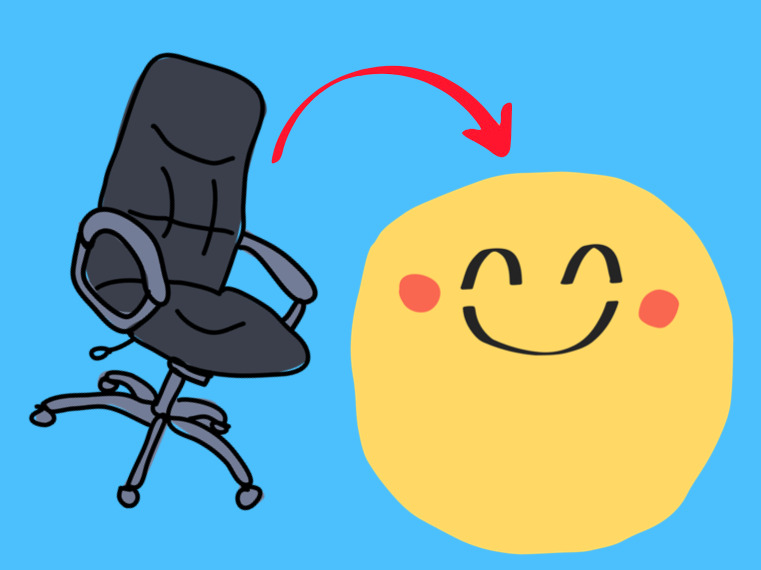
They found a dose-response relationship. This meant that the more frequently people moved, the more benefits they gained.
In the Body Electric podcast, Columbia University researcher Dr Keith Diaz said a preliminary analysis of the data showed:
• People who moved every 30 minutes improved their fatigue levels by 30%.
• People who moved every hour improved their fatigue levels by 25%.
• People who moved every 2 hours improved their fatigue levels by 20%.
Here’s the thing, though . . .
Dr Diaz pointed out that most people weren’t getting all their exercise breaks in. On average, they took eight movement breaks each day (note: the researchers recommended 16 movement breaks a day), but they still experienced benefits.
Here’s what I take from all of this . . .
You don’t have to do this perfectly. There are no hard and fast rules. Doing some movement is better than doing no movement.
All movement matters. It all adds up.
Although movement is natural and good for the mind and body, my brain often resists the thought of getting up and moving (“No! I don’t want to get out of this cosy chair!”).
What’s up with that?
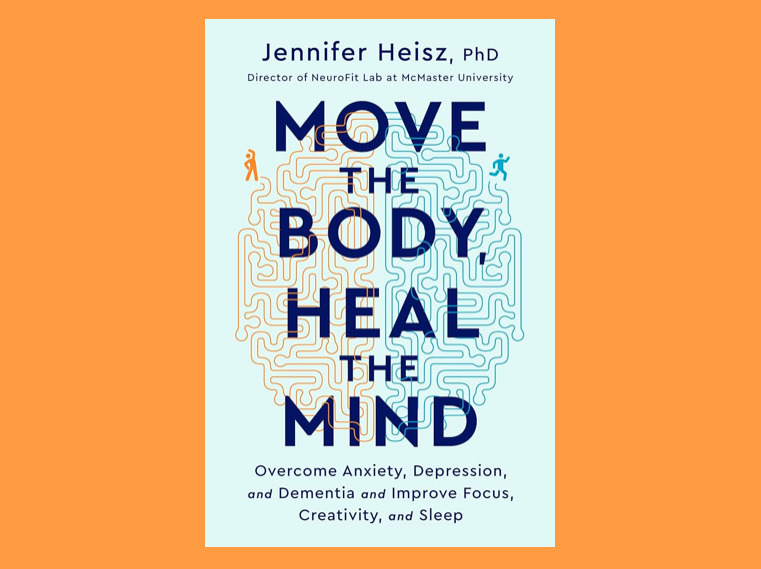
In the book Move the Body, Heal the Mind, Dr Jennifer Heisz explains that our brains hate exercise for two reasons:
1) The brain doesn’t want to expend energy; and
2) Exercise can be stressful.
This has to do with how our brains are wired and our deep evolutionary programming.
If we go back in time, our hunter-gatherer ancestors had to be constantly on the move to gather food, build shelter and run from hungry animals. All of this activity required a lot of energy. Since food was scarce and energy was limited, hunter-gatherers had to conserve their energy.
If you were to offer a hunter-gatherer a free meal and a comfortable place to stay, would they take it? You bet they would.
The problem is our brains haven’t changed in thousands of years. We still have the same brain wiring as our ancient ancestors.
This is why my brain often throws a tantrum and comes up with all sorts of excuses to avoid my morning workout.
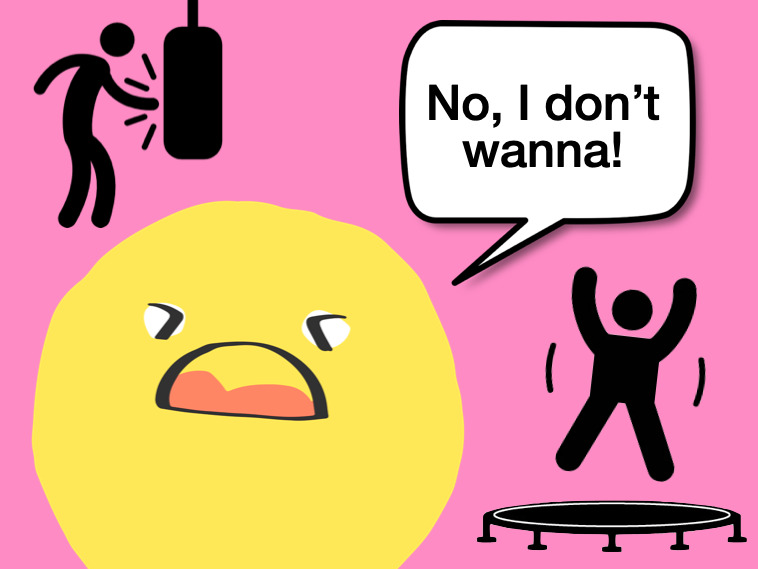
In this modern world, with all the calorie-dense fast food, comfy chairs, and modern conveniences, our brains get confused.
As evolutionary psychologist Dr Doug Lisle, author of The Pleasure Trap, states, in the modern world:
“What feels right is wrong. And what feels wrong is right.”
Understanding that we operate with an ancient brain that isn’t suited to this modern world opens up new possibilities. For example, you can use your prefrontal cortex (the rational part of your brain) to override the primitive instinct to stay comfortable.
Here are some strategies I’ve been experimenting with to get me taking regular five-minute movement breaks:
I’ve strategically placed electronic timers in every room I spend a lot of time in (e.g., my office, outdoor desk, and dining room). Before I sit down to start a task, I set a timer for 25 minutes.
When the timer goes off, that cues my brain to get up and move.
When the timer goes off, I usually jump on my treadmill for a five-minute walk. But not always.
Whenever I feel like doing something different, I play a little game with myself.
The game is simple:
I roll a dice with different movement activities I wrote on each side. Whatever activity it lands on, I do it.
Here are the activities currently listed on my dice:
• Pick up a set of dumbbells and do some bicep curls
• Do some stretches on my yoga matt
• Use resistance bands
• Go outside and walk around my garden
• Do squats
• Hit play on an upbeat track and dance!
Sometimes, the timer going off will not be enough to get you up and moving. You may need to have a few words with your brain.
I often find myself negotiating with my brain, trying to convince myself to get up and move.
Me: “Come on, it’s time to get up.”
Brain: “Noooo! It’s nice and comfy here.”
Me: “On the count of three, we’re going to do this . . . 1 . . . 2. . . 3.”
Be gentle with your brain. Remember, it’s wired for comfort.
There’s a reason I have stretch bands hanging on door knobs, a yoga mat rolled out on my dining room floor, a rack of dumbbells next to my desk, and comfortable walking shoes always on my feet. All of these little things make it easy for me to move.
Look around your workspace: is there anything that makes it hard for you to move? Identify any barriers and do what you can to remove them.
Instead of stopping to take a movement break, can movement become part of what you do?
For instance, I wrote the first draft of this blog as I walked at a slow pace on my treadmill desk, and I edited it while pedalling at my cycle desk.
Remember, movement doesn’t need to be strenuous to be effective. Light-intensity movement delivers results.
I recently finished reading an excellent book called Creative First Aid: The science and joy of creativity for mental health. It is packed full of creative practices to help calm your nervous system.
One of the practices the authors suggest is creating a playlist of songs called ‘I Dare You Not to Move’. This playlist is a selection of songs that make you want to dance.
On a movement break, I close my blinds and hit play on one of my favourite dance tracks.
Don’t consider yourself much of a dancer? No problem! Sway your hips from side to side or throw your hands in the air and make some circles with them.
Even though it may feel good in the moment to stay seated in a comfy chair, I have to regularly remind myself that movement makes me feel good (and less stiff and achy).
Remember, whenever we force ourselves to get up and move, we go against our brain’s programming. This is why these reminders are so important.
Before stepping onto the treadmill to do a run, I say to myself, “This is good for me. You won’t regret doing this”. And you know what? I always feel better after a workout.
What is something you already do on a regular basis?
It could be making a cup of tea, preparing lunch, or putting on your shoes.
According to the Tiny Habits Method, the key to forming habits is to attach a tiny behaviour to a pre-existing habit. For example:
• After I put on the kettle, I will do five wall push-ups.
• After I shut down my computer, I will do arm circles for 30 seconds.
• After I put my lunch in the microwave, I will march on the spot.
• After I pick up the phone, I will stand up to walk and talk.
• After I notice I am feeling sluggish, I will hit play on an upbeat song.

If you want to wire in this new movement break quickly, celebrate after moving your body (i.e. release a positive emotion). I tell myself, “Good job Jane!”. But usually, the movement leaves me feeling good, so it’s not always necessary.
The science is in. We know breaking up periods of sitting with regular five-minute movement breaks can make a big difference to our mental and physical health. The good news is you don’t even have to break a sweat to experience these benefits (light-intensity movement will do the job).
If you can’t manage moving every half hour, no problem. Do what you can. Some movement is better than no movement. On that note, is it time to get up and move? Let’s do this together. How about a light walk? Or a short dance break?
On the count of three . . . one . . . two . . . three. Let’s go!

It had been an intense year of work and study. I desperately needed a break.
So I packed a backpack and went hiking with a group of friends. We did the sorts of things you see people do in wilderness films: we swam in rivers, slept under the stars, and ate the simplest of meals.
Five days later, I re-emerged from the forest feeling re-energised and with a new perspective. I felt excited about life again.
If you’ve ever skipped a holiday or used your holidays to catch up on work, you know at some level this is bad for your soul.
Research shows people who skip holidays are more likely to:
• suffer from burnout;
• feel emotionally exhausted;
• be less productive;
• have trouble concentrating during their free time after work; and
• find it harder to deal with the challenges of work, study, and life.
Think of the last time you felt really exhausted. How easy was it for you to do your work?
With a tired mind, it’s hard to get anything done. You can’t do your best work.
Let’s face it . . .
You’re not a machine.
You’re a human being.
Your energy is finite.
You have limits.

Following any period of intense or stressful work, you need to rest and recover.
If you choose to ignore your biological limits and burn yourself out, it can take 12 months to fully recover. It’s your choice. Your call. Personally, I wouldn’t risk it.
So it’s time to get serious about rest and in particular, holidays.
Let’s take a quick look at the science . . .
Research by Sabine Sonnentag and her team found we need to experience the following four things to fully recover from stress:
1) Relaxation;
2) Mental detachment from work;
3) A sense of being in control; and
4) Mastery experiences.
In his book Rest: Why You Get More Done When You Work Less, Alex Soojung-Kim Pang encourages us to think of breaks as being like meals. You want your meal (i.e. your break) to be nourishing, so it needs to be high in all four of the components listed above.
The good news is you can train yourself to get better at doing these four things. It just takes practice.
Below we explore each of these factors in more detail. Read on!
This is about calming your mind and body.
What’s the best way to relax?
There are no hard and fast rules but you could try:
• Meditating;
• Having a massage;
• Listening to relaxing music;
• Spending time in nature;
• Doing yoga;
• Breathing exercises; and
• Taking a long hot bath.
What do these activities have in common?
They require very little effort. And they make you feel good!
Research by Frederickson (2001) found that when people feel good (i.e. they experience positive emotions) this helps to boost their energy levels.
Have you ever found yourself worrying about school/work when you weren’t at school/work?
When you do this, you’re wasting your precious (and finite) mental energy. But what’s even worse is that no recovery can occur when you worry.
One study by Sonnentag, Binnewies and Mojza (2008) found that low psychological detachment from work in the evening is associated with feeling exhausted and tired in the morning.
Want to wake up feeling refreshed and alert? Then stop any negative thoughts about work and school as soon as you get home.
Easier said than done, right?
Again, it’s just practice.
Here are some strategies that help me to switch off from my work/study:
• Set a worry time (worry o’clock): Find yourself worrying? Quickly jot down the thought that is bothering you. Then tell yourself you’ll revisit that thought later at worry o’clock.
• Create non-work zones in your room/home: Deliberately segment work and off-work life. Don’t bring any work into your non-work areas.
• Don’t do any work on your holidays: Put your books and notes away. Your top priority is to have fun, relax and engage in mastery experiences (see point 4 below).
• Get moving: Engaging in intense physical exercise can provide ‘time out’ from worrisome thoughts. When I exercise, my focus is just on doing each movement (nothing else). I tune into how my body feels. Increased levels of endorphins, serotonin, and dopamine following exercise also help with the recovery process.
Do you feel in control of your time when you’re not at school or work? Can you engage in activities that you enjoy and find meaningful?
If the answer is no, you need to work on feeling more in charge of your life.
Here are some questions to consider:
• Are you overscheduled?
• Could you cut back on a few activities/commitments to free up more time for fun and relaxation?
• Can you outsource any activities?
• Can you do certain activities more efficiently to free up more time?
• Can you reduce time confetti in your life?
These are experiences that challenge and stretch you in some way. When you engage in them, you tend to forget about your work and/or school.
These activities require you to exert a bit of effort, but you don’t want them to leave you feeling completely exhausted.
Here are some examples of mastery experiences:
• Physical exercise;
• Learning a new instrument (e.g. the piano);
• Learning a foreign language;
• Volunteering in the community; and
• Taking a free online course on a topic that interests you.
As a general rule of thumb, try to limit time on digital devices over the holidays.
Let me be clear: technology can be a great tool to help you engage in a mastery experiences. But depending on how you use it, it can also inhibit the recovery process.
Screen time leisure activities, such as scrolling on your phone and watching Netflix, don’t really challenge us. We typically sit down and enter a passive, zombified state. This in turn can lead to boredom, apathy and depression.
For every hour you spend in front of a screen, that’s an hour you could have spent at the beach, going for a walk in nature, working on a creative project or learning how to cook a new dish.
Here’s another reason to limit your screen time . . .
If you’re looking at a screen 30 minutes before going to bed, you’re messing with your melatonin (a hormone that makes you feel sleepy). The light emitted from screens has been shown to suppress the production of melatonin, thereby making it harder for people to fall asleep.
Scrolling through your social media feed so close to bedtime also means you’re at risk of seeing content that upsets you.
Put simply . . .
As Demerouti and her team state:
“The better an individual’s physiological and psychological state before bedtime, the longer and better the quality of sleep she/he will have. A better quality and quantity of sleep in turn leads to a better psychological and energetic state the next morning before going to work.”
So put your phone to bed at least 30 minutes before you plan on going to bed. This simple action could change both your mood and outlook in dramatic and profound ways.
For these holidays, I encourage to explore and experiment with different ways to make your break truly restorative. And most importantly, make sleep your top priority.
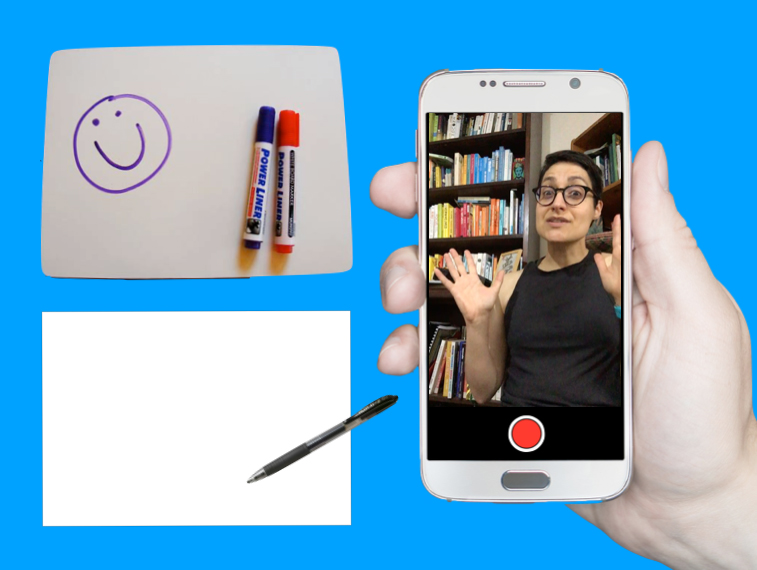
Research shows active recall (aka retrieval practice) is a highly effective strategy for remembering information. This strategy will take your studies and your grades to the next level.
Active recall involves bringing information to mind without looking at your books and notes.
I have spent the last 30 days experimenting with this excellent learning strategy. In this blog, I’ll share what I did and how I kept the process interesting for my brain.
I no longer need to study for tests and exams.
So, why did I spend 30 days using active recall strategies?
In my line of work, I need to constantly come up with new and original content to present to students. I also need to memorise this content. Why?
Because if I was to read from a sheet of notes or text heavy slides that would be really boring for students. I want to connect with students and to do this, I have to be able to deliver the content off the top of my head with speed and ease.
This is where active recall enters the picture.
Active recall helps to speed up the learning process. It allows you to learn more in less time.
Below I share some of the ways I use active recall to learn new presentation content. Keep in mind, you can use all of these strategies to prepare for an upcoming test or exam.
Whiteboards are wonderful learning tools. Here’s how I use a whiteboard to do active recall . . .
I push my speech notes to the side, so I can’t look at them. Then I grab a marker and say to myself, “What can you remember? Go!”.
I write out everything I can remember on the whiteboard. Once I’ve exhausted my memory, I pick up my notes and check to see how I went (using a red marker to make corrections).
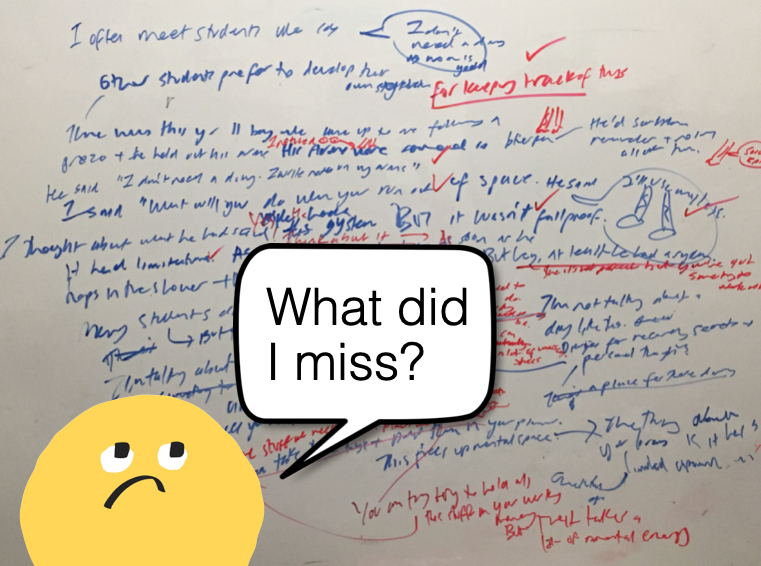
No whiteboard? No problem!
I pick up a pen and sheet of paper and start scribbling out whatever I can remember on the topic. When I get stuck, I pause and take a few deep breaths as I try to scan my brain for the information.
I regularly remind myself that it is okay to not remember the content. “This is how the process goes!”, I say to myself. There is no point beating myself up. That only leads to feelings of misery and not wanting to do active recall practice.
After having a shot at it, I take out my notes, pick up a red pen, and begin the process of checking to see how I went.
Sick of writing? I get it.
Try drawing out the information instead. Alternatively, you can use a combination of words and pictures, which is what I often do.
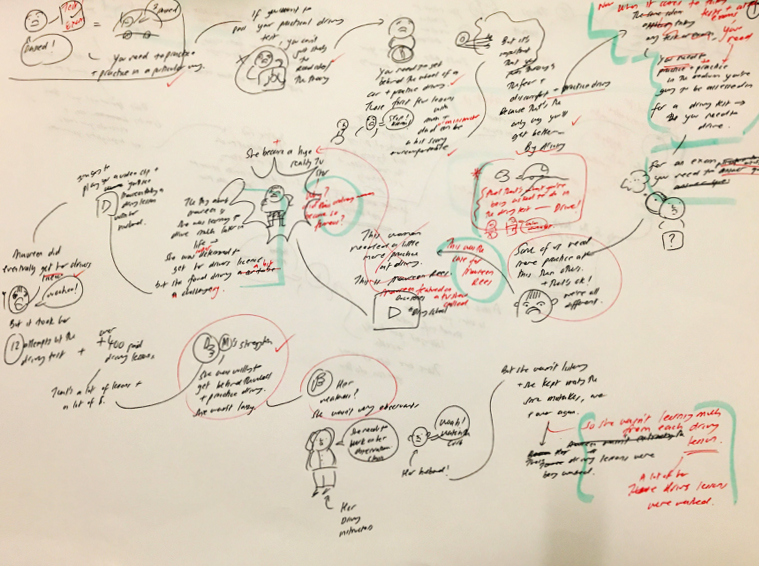
Grab a blank piece of paper (A3 size is best) and create a mind map of everything you can remember on a topic (no peeking at your notes). Then check your notes or the original mind map to see what you remembered correctly and incorrectly.
Writing and drawing out information can take time. If you want to speed up the process, you can talk to yourself.
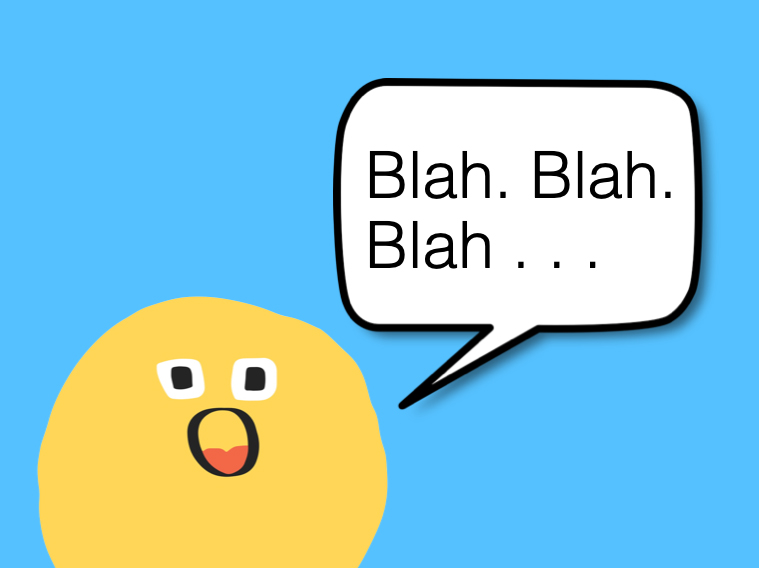
But don’t do this in your head. It’s too easy to just say “Yeah, yeah, I know this stuff!”. You need to speak it out loud as this forces you to have a complete thought. Then, check your notes to see how you went.
The only downside with this approach is you don’t have a tangible record of what you recalled, which brings me to the next strategy . . .
I make videos of myself presenting the content (without referring to my notes). Although I use special software and tools to make my videos, you don’t need any fancy equipment. Your phone will do the job. Here’s what you can do . . .
Set your phone up so the camera is facing you. Now hit the record button and tell the camera what you’re going to do active recall on. Have a shot at explaining the idea. Then stop recording and hit the play button.

Watching yourself struggle to remember information is often hard viewing. But this is where it’s super important to double down on telling yourself kind thoughts (e.g., “I’m still learning this content. It’s going to be rusty and feel clunky – that’s okay!”).
You need to take a deep breath and keep watching because the video will give you valuable feedback.
For example, if you stop midsentence and you don’t know how to proceed, that tells you something: you don’t know this stuff so well! Make a note. This part of the content needs your attention.
Hand your notes over to a friend, parent, or sibling. Now get them to ask you questions on the content.
I sat with my mum and showed her a print out of my slides for a new presentation. The slides were just pictures (no text).
As I went through the slides, I explained the ideas to mum. I made notes of any sections I was rusty on. Mum also asked lots of questions, which allowed me to think more deeply about the content.
When it came crunch time (a few days before the final presentation), I printed out my presentation slides (16 per page) and used each slide as a prompt. I’d look at the slide and say, “What do I need to say here?”.

Sometimes I wrote out what I’d be saying in relation to each slide (without looking at my notes). Then I checked my original notes to make sure I hadn’t forgotten anything.
It’s really important that you don’t skip the stage of checking to see how you went, especially as you become more confident with the content.
At times, I found myself thinking “I know this stuff! I don’t need to check my notes” but then another part would say, “You better just check . . . just to be on the safe side”.
I’m glad I forced myself to check because more often than not I would discover that I had missed a crucial point.
Zines are cute little booklets you can create on any topic you like. They are fun to make, so I thought I’d try making a mini zine on the main points of some new content I had to learn.
I folded up an A4 page into a booklet and then I sketched out the main points on each panel.
I create a deck of flashcards on some key ideas (question on one side and the answer on the back) and then I test myself with them.
I read the question and before flipping the card, I write out the answer on a sheet of paper or say it out loud. Then I check to see how I went.
The beauty of flashcards is they are small and portable (they can easily fit in your pocket or bag). Whenever you have a spare minute or two, you can get a little active recall practice in.
It’s not enough to do active recall just once on the content you need to learn. For best results, you want to practice recalling the information several times over a period of time.
I didn’t follow a strict schedule for the 30 days. I had my notes for each important chunk of information I had to learn pinned to eight different clipboards.
Every morning, I’d pick up a different clipboard and I’d practice that specific content. I knew as long as I’d had a good night’s sleep in between practice sessions that the information was being strengthened in my brain.
Doing active recall is a bit like doing a high intensity workout: it can be exhausting. But you must remember, just like a high intensity exercise session is an effective way to train and get fit, active recall is an effective way to learn. Unlike less effective strategies (e.g., rereading and highlighting), you can learn a lot in a short space of time with active recall.
The key is to expect the process to be a little uncomfortable. Don’t fight the discomfort. If you trust the process and persevere, it won’t be long before you begin to see amazing results.
Just because active recall is challenging to do that doesn’t mean you can’t have fun with it.
Using a combination of different active recall strategies is one way to keep things fresh and interesting for your brain. But you may wish to try the following things to add a little boost of fun to your active recall sessions:
• Use a different type of pen
• Use a different coloured pen
• Change the type of paper or notebook you use (e.g., instead of using lined paper, use blank A3 paper)
• Incorporate movement into your active recall sessions (e.g., walk and test yourself with some flashcards)
• Change your study environment (e.g., go to the library or study outside)
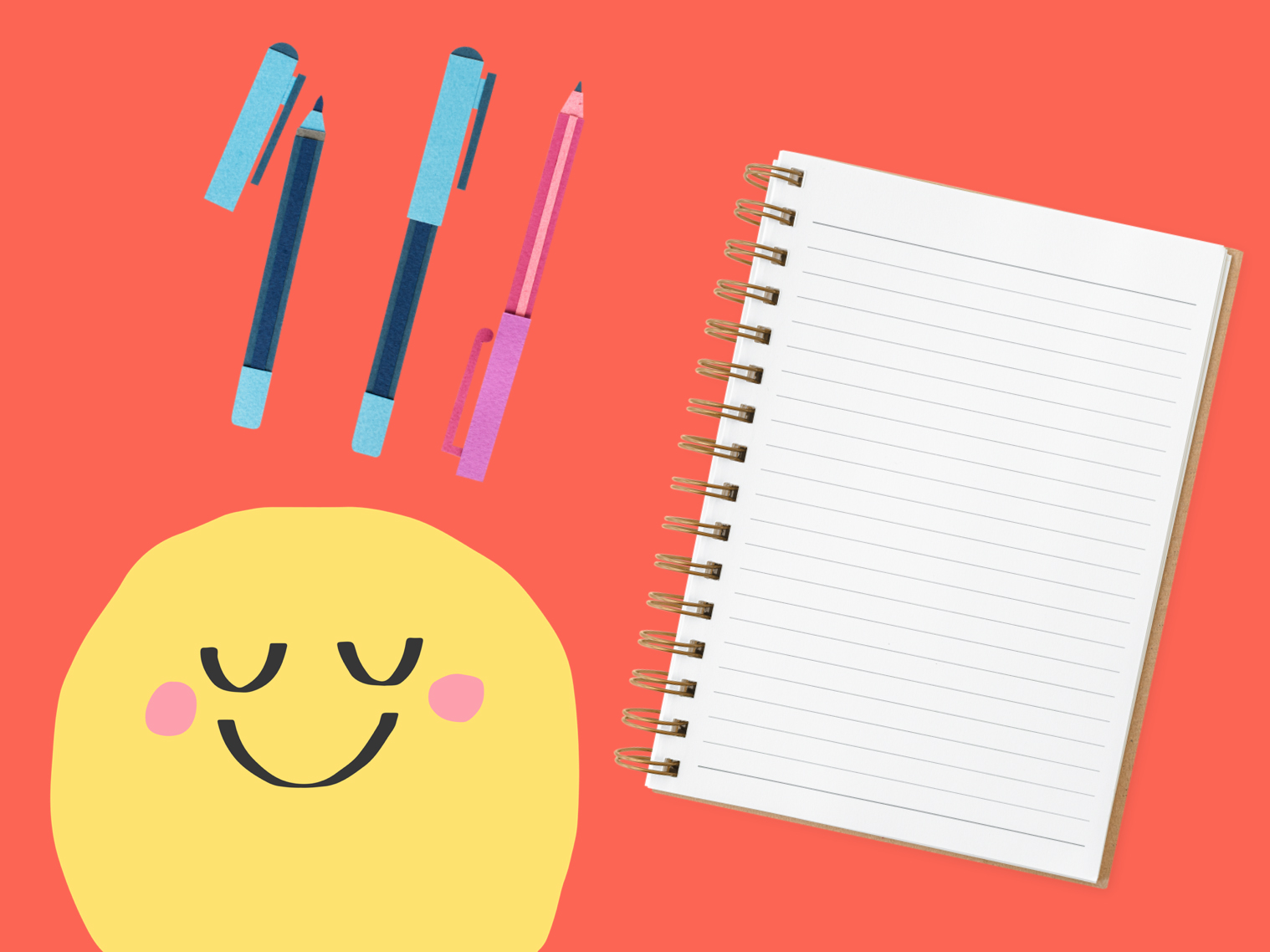
Like I said, active recall is challenging to do, especially when you first start learning new content. You can feel awkward and clumsy. For this reason, it’s easy to make excuses to get out of doing it (e.g., “I’m too tired”, “I’m not ready to do it”, and “It’s not the right time”).
This is where you need to harness the power of habits.
Find a set time in your day to do a little active recall practice. For instance, during my 30 days of active recall, I scheduled my practice sessions for first thing in the morning. I knew after I washed my face, I would sit down to practice.
Incorporating active recall into my morning routine worked really well for me. I was getting the hardest thing done first thing in the day. And once it was done, I could relax. It was done and dusted!
At a certain point, I became more confident with the content and I found I was on a roll. I felt motivated to do active recall.
This is when I started to look for spare moments in the day to squeeze in a few extra mini practice sessions.
For example, one day I found myself waiting in a car. I grabbed a paper shopping bag and started scribbling out the content onto the bag. As soon as I got home, I checked the shopping bag against my notes.

I hope you can see that there’s no one set way to do active recall. This is a highly effective strategy you can be creative with. As long as you’re testing yourself and checking to see how you went, you can’t go wrong.
And if you do make a mistake? It’s no big deal. If you check to see how you went, you won’t embed the error in your long-term memory.
Dr Jane Genovese delivers interactive sessions on learning to learn, combating procrastination, exam preparation, how to focus in the age of distraction, habit formation and much, much more!
Get FREE study and life strategies by signing up to our newsletter:
© 2024 Learning Fundamentals